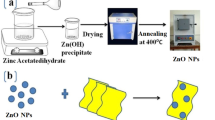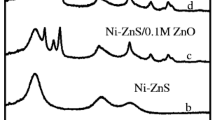Abstract
C–N-co-doped ZnO was successfully developed as a visible-light photocatalyst by incorporating carbon (C) and nitrogen (N) into the ZnO lattice using a two-step sol–gel and physical grinding method. Characterizations included DRS, FTIR, XRD, SEM, XPS, and TGA all confirming successful doping. The DRS analysis confirmed the shift in photoresponse from the UV region to the visible-light region. The XRD analysis confirmed the hexagonal wurtzite structure of ZnO, with slight redshifts in 2θ values for the 5% C–N–ZnO NPs. SEM images showed particles of varying sizes while the XPS analysis confirmed the presence of C, N, Zn, and O. The C–N-co-doped ZnO exhibited enhanced photocatalytic activity, decomposing 91% of methylene blue in 140 min under visible light. The degradation followed a pseudo-second-order kinetic reaction, with decomposition rates increasing with higher photocatalyst quantities and decreasing with higher dye concentrations.
Graphical abstract

Uniform and stable C–N-co-doped nanocomposites were prepared and their excellent photocatalytic dye degradation under visible-light irradiation was observed.




Similar content being viewed by others
Data availability
This manuscript contains all of the data generated or analyzed during this research.
References
K. Ahmad, H. Ghatak, S. Ahuja, Photocatalytic technology: a review of environmental protection and renewable energy application for sustainable development. Environ. Technol. Innov. 19, 100893 (2020). https://doi.org/10.1016/j.eti.2020.100893
N. Serpone, A.V. Emeline, Semiconductor photocatalysis—past, present, and future outlook. J. Phys. Chem. Lett. 3(5), 673–677 (2012). https://doi.org/10.1021/jz300071j
F. Imtiaz, J. Rashid, M. Xu, Semiconductor nanocomposites for visible light photocatalysis of water pollutants, in Concepts of Semiconductor Photocatalysis. ed. by M. Rahman, A. Khan, A. Asiri, I. Inamuddin (IntechOpen, Rijeka, 2019). https://doi.org/10.5772/intechopen.86542
A.I. Sterhov, I.Y. Loshkarev, Determination of the proportion of natural light in solar radiation using the method of conversion of lighting units into energy. J. Phys.: Conf. Ser. (2019). https://doi.org/10.1088/1742-6596/1353/1/012002
J. Xu, W. Wang, S. Sun, L. Wang, Enhancing visible-light-induced photocatalytic activity by coupling with wide-band-gap semiconductor: a case study on Bi2WO6/TiO2. Appl. Catal. B (2012). https://doi.org/10.1016/j.apcatb.2011.09.025
P. Cheng, Y. Yang, Narrowing the band gap: the key to high-performance organic photovoltaics. Acc. Chem. Res. 53(6), 1218–1228 (2020). https://doi.org/10.1021/acs.accounts.0c00157
R. Medhi, M.D. Marquez, T.R. Lee, Visible-light-active doped metal oxide nanoparticles: review of their synthesis, properties, and applications. ACS Appl. Nano Mater. 3(7), 6156–6185 (2020). https://doi.org/10.1021/acsanm.0c01035
X. Zhang et al., Carbon-doped ZnO nanostructures: facile synthesis and visible light photocatalytic applications. J. Phys. Chem. C 119(35), 20544–20554 (2015). https://doi.org/10.1021/acs.jpcc.5b07116
M. Chiesa, S. Livraghi, M.C. Paganini, E. Salvadori, E. Giamello, Nitrogen-doped semiconducting oxides. Implications on photochemical, photocatalytic and electronic properties derived from EPR spectroscopy. Chem. Sci. 11(26), 6623–6641 (2020). https://doi.org/10.1039/D0SC02876B
J. Lynch, C. Giannini, J. Cooper, A. Loiudice, I. Sharp, R. Buonsanti, Substitutional or interstitial site-selective nitrogen doping in TiO2 nanostructures. J. Phys. Chem. C 119, 7443–7452 (2015). https://doi.org/10.1021/jp512775s
M. Zheng, J. Wu, One-step synthesis of nitrogen-doped ZnO nanocrystallites and their properties. Appl. Surf. Sci. 255, 5656–5661 (2009). https://doi.org/10.1016/j.apsusc.2008.10.091
L. Sun, H. He, L. Hu, Z. Ye, Evidence for the carbon-nitrogen complex in ZnO nanostructures with very high nitrogen doping. Phys. Chem. Chem. Phys. 15(5), 1369–1373 (2013). https://doi.org/10.1039/c2cp43657d
A. Khan, M. Danish, U. Alam, S. Zafar, M. Muneer, Facile synthesis of a Z-scheme ZnIn2S4/MoO3 heterojunction with enhanced photocatalytic activity under visible light irradiation. ACS Omega 5(14), 8188–8199 (2020). https://doi.org/10.1021/acsomega.0c00446
D.G. Ayu et al., Photocatalytic degradation of methylene blue using N-doped ZnO/carbon dot (N-ZnO/CD) nanocomposites derived from organic soybean. ACS Omega 8(17), 14965–14984 (2023). https://doi.org/10.1021/acsomega.2c07546
J. Li, N. Wu, Semiconductor-based photocatalysts and photoelectrochemical cells for solar fuel generation: a review. Catal. Sci. Technol. 5(3), 1360–1384 (2015). https://doi.org/10.1039/C4CY00974F
F. Zou, J. Hu, W. Miao, Y. Shen, J. Ding, X. Jing, Synthesis and characterization of enhanced photocatalytic activity with Li+-doping nanosized TiO2 catalyst. ACS Omega 5(44), 28510–28516 (2020). https://doi.org/10.1021/acsomega.0c03054
A.S. Alshammari et al., Visible-light photocatalysis on C-doped ZnO derived from polymer-assisted pyrolysis. RSC Adv. 5(35), 27690–27698 (2015). https://doi.org/10.1039/c4ra17227b
M. Samadi, M. Zirak, A. Naseri, E. Khorashadizade, A.Z. Moshfegh, Recent progress on doped ZnO nanostructures for visible-light photocatalysis. Thin Solid Films 605, 2–19 (2016). https://doi.org/10.1016/j.tsf.2015.12.064
P. Kumari, K.P. Misra, S. Chattopadhyay, S. Samanta, A brief review on transition metal ion doped ZnO nanoparticles and its optoelectronic applications. Mater. Today: Proc. 43, 3297–3302 (2021). https://doi.org/10.1016/j.matpr.2021.02.299
Z. Hammami, C. Bilel, A. Othmani, R. Chaabane, R. Schneider, Manganese doping effect on ZnO photocatalytic and electric properties. S. Afr. J. Chem. 78, 27–35 (2024)
I. Aadnan, O. Zegaoui, A. El Mragui, I. Daou, H. Moussout, J.C.G. da Silva, Structural, optical and photocatalytic properties of Mn doped ZnO nanoparticles used as photocatalysts for azo-dye degradation under visible light. Catalysts (2022). https://doi.org/10.3390/catal12111382
X. Zhang et al., Carbon-doped ZnO nanostructures: facile synthesis and visible light photocatalytic applications. J. Phys. Chem. C 119, 20544–20554 (2015). https://doi.org/10.1021/acs.jpcc.5b07116
A.M. Ferrari-Lima, R.P. de Souza, S.S. Mendes, R.G. Marques, M.L. Gimenes, N.R.C. Fernandes-Machado, Photodegradation of benzene, toluene and xylenes under visible light applying N-doped mixed TiO2 and ZnO catalysts. Catal. Today 241, 40–46 (2015). https://doi.org/10.1016/j.cattod.2014.03.042
C. Wu, Facile one-step synthesis of N-doped ZnO micropolyhedrons for efficient photocatalytic degradation of formaldehyde under visible-light irradiation. Appl. Surf. Sci. 319, 237–243 (2014). https://doi.org/10.1016/j.apsusc.2014.04.217
J.J. Macías-Sánchez et al., Synthesis of nitrogen-doped ZnO by sol–gel method: characterization and its application on visible photocatalytic degradation of 2,4-D and picloram herbicides. Photochem. Photobiol. Sci. 14(3), 536–542 (2015). https://doi.org/10.1039/C4PP00273C
M. Samadi, M. Zirak, A. Naseri, E. Khorashadizade, A.Z. Moshfegh, Recent progress on doped ZnO nanostructures for visible-light photocatalysis. Thin Solid Films 605, 2–19 (2016). https://doi.org/10.1016/j.tsf.2015.12.064
A. Hassan, A. Jalil, S.Z. Ilyas, M.F. Iqbal, S.Z. Ali Shah, Y. Baqir, Green-route synthesis and ab-initio studies of a highly efficient nano photocatalyst:Ce/zinc-oxide nanopetals. Heliyon 10(3), e25581 (2024). https://doi.org/10.1016/j.heliyon.2024.e25581
X. Qing, C. Zhang, J. Gong, S. Chen, Ab initio study of photoelectric properties in ZnO transparent conductive oxide. Vacuum 191(June), 110391 (2021). https://doi.org/10.1016/j.vacuum.2021.110391
F. Gallino, C. Di Valentin, G. Pacchioni, M. Chiesa, E. Giamello, Nitrogen impurity states in polycrystalline ZnO. A combined EPR and theoretical study. J. Mater. Chem. 20(4), 689–697 (2010). https://doi.org/10.1039/B915578C
Y.H. Lu, S.P. Russo, Y.P. Feng, Effect of nitrogen and intrinsic defect complexes on conversion efficiency of ZnO for hydrogen generation from water. Phys. Chem. Chem. Phys. 13(35), 15973–15976 (2011). https://doi.org/10.1039/C1CP20908F
H. Pan et al., Room-temperature ferromagnetism in carbon-doped ZnO. Phys. Rev. Lett. 99(12), 127201 (2007). https://doi.org/10.1103/PhysRevLett.99.127201
S. Liu, C. Li, J. Yu, Q. Xiang, Improved visible-light photocatalytic activity of porous carbon self-doped ZnO nanosheet-assembled flowers. CrystEngComm 13(7), 2533–2541 (2011). https://doi.org/10.1039/C0CE00295J
F. Paraguay-Delgado, L.A. Hermida-Montero, J.E. Morales-Mendoza, Z. Durán-Barradas, A.I. Mtz-Enriquez, N. Pariona, Photocatalytic properties of Cu-containing ZnO nanoparticles and their antifungal activity against agriculture-pathogenic fungus. RSC Adv. 12(16), 9898–9908 (2022). https://doi.org/10.1039/D2RA00863G
C.-W. Lin et al., Interactions between liquid ammonia and graphitic materials. RSC Appl. Interfaces (2024). https://doi.org/10.1039/D3LF00194F
Z. Liu, D. Yao, F. Wu, Promotion of Cu−SSZ-13 on urea decomposition. Energy Fuels 35(9), 8163–8172 (2021). https://doi.org/10.1021/acs.energyfuels.0c04347
Y. Shaban, N.A. Alharbi, Sunlight-mediated photocatalytic removal of phenanthrene from wastewater using carbon-doped zinc oxide (C-ZnO) nanoparticles. Environ. Sci. Pollut. Res. 29(31), 47818–47831 (2022). https://doi.org/10.1007/s11356-022-19214-x
I. Groeneveld, M. Kanelli, F. Ariese, M.R. van Bommel, Parameters that affect the photodegradation of dyes and pigments in solution and on substrate—an overview. Dyes Pigm. 210, 110999 (2023). https://doi.org/10.1016/j.dyepig.2022.110999
Acknowledgments
Much gratitude to the Bangladesh Council of Scientific and Industrial Research for the XRD, DRS and FE-SEM study of the samples.
Funding
This research was funded by The Queen Elizabeth Commonwealth Scholarship research grants and Grant for Advance Research in Education (GARE), Project ID: PS2019909 from the Ministry of Education, Government of the People’s Republic of Bangladesh.
Author information
Authors and Affiliations
Contributions
Conceptualization—Abdulla-Al-Mamun M; methodology—Shikuku R O; formal analysis—Shikuku R O; investigation—Shikuku R O; resources—Abdulla-Al-Mamun M; writing—original draft preparation—Shikuku R O; writing—review and editing—Abdulla-Al-Mamun M; visualization—Shikuku R O; supervision—Abdulla-Al-Mamun M. All authors have read and agreed to the published version of the manuscript.
Corresponding author
Ethics declarations
Conflict of interest
The authors declare no conflict of interest.
Additional information
Publisher's Note
Springer Nature remains neutral with regard to jurisdictional claims in published maps and institutional affiliations.
Supplementary Information
Below is the link to the electronic supplementary material.
Rights and permissions
Springer Nature or its licensor (e.g. a society or other partner) holds exclusive rights to this article under a publishing agreement with the author(s) or other rightsholder(s); author self-archiving of the accepted manuscript version of this article is solely governed by the terms of such publishing agreement and applicable law.
About this article
Cite this article
Shikuku, R., Abdulla-Al-Mamun, M. A new visible-light-responsive carbon–nitrogen-co-doped zinc oxide photocatalysts: Applications on dye remediation. MRS Advances (2024). https://doi.org/10.1557/s43580-024-00857-6
Received:
Accepted:
Published:
DOI: https://doi.org/10.1557/s43580-024-00857-6




